19 Magical Oases In The Heart Of The Sahara
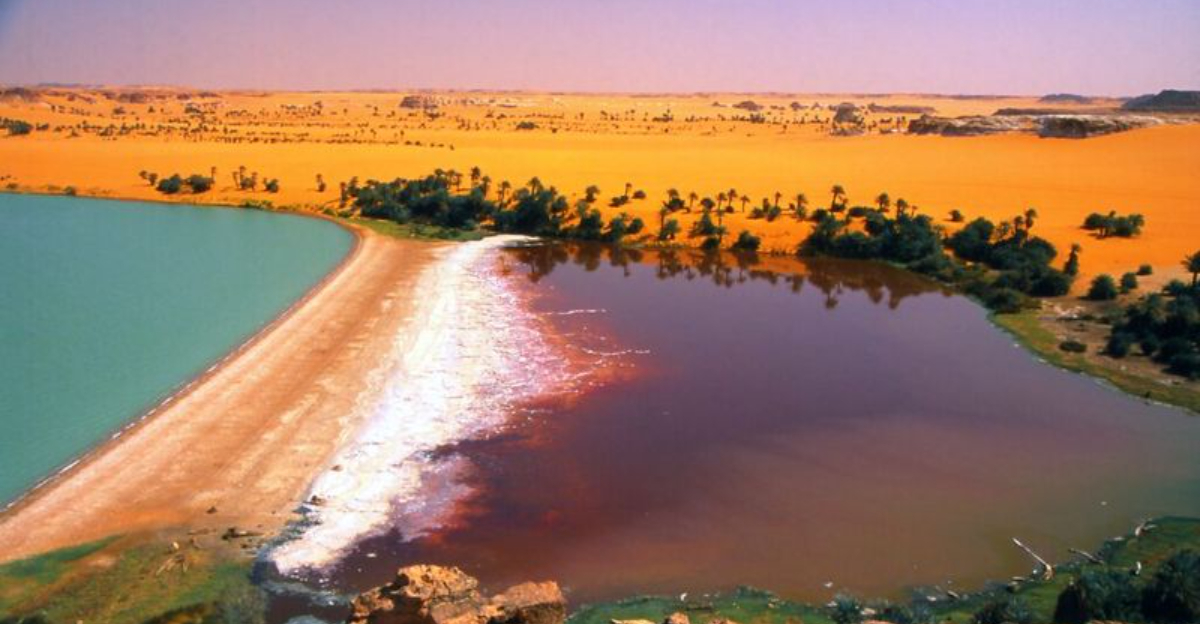
Beneath the blazing sun and golden dunes of the Sahara lie pockets of life that seem almost too magical to be real. These oases, some hidden deep within the desert’s heart, are where palm trees sway beside still blue pools, and ancient mud-brick towns whisper stories of caravans, kings, and survival.
Did you know some of these oases have been inhabited for thousands of years, serving as lifelines on trade routes stretching across North Africa? Others have transformed into peaceful retreats where travelers can sip mint tea under starry skies.
In this journey through the Sahara’s 20 most enchanting oases, you’ll discover the quiet resilience and natural beauty that blooms where you least expect it. Would you dare to wander this desert paradise?
1. Siwa Oasis, Egypt
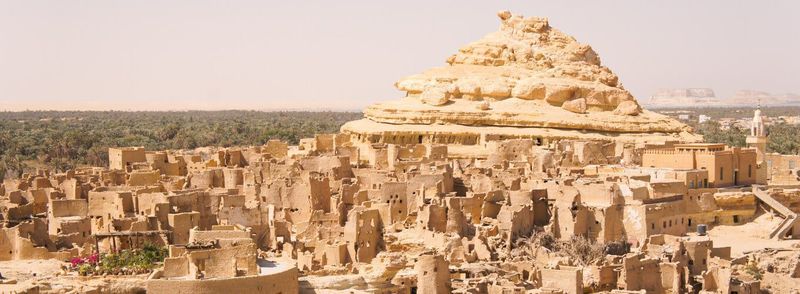
Alexander the Great traveled here to consult the Oracle of Amun in 331 BCE. Today, Siwa remains one of Egypt’s most isolated and enchanting oases, surrounded by date palms and freshwater springs.
The mud-brick fortress of Shali dominates the landscape, its walls melting slowly back into the earth after heavy rains damaged it in the 1920s. Locals still speak their own Berber language called Siwi.
You can float in the salt lakes, explore ancient temples, or watch the sunset paint the desert gold from Fatnas Island. The dates and olives grown here are famous throughout Egypt for their exceptional quality.
2. Timia, Niger
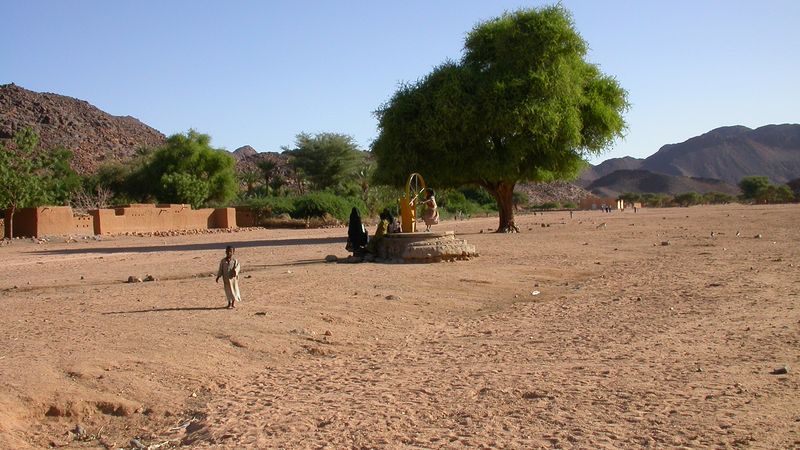
Hidden within the Aïr Mountains, Timia glows like an emerald against Niger’s dusty landscape. Silver artisans craft intricate jewelry in this village, where gardens overflow with pomegranates, figs, and citrus fruits.
During the rainy season, a spectacular waterfall cascades down the rocky mountainside, transforming this quiet settlement into a paradise. The whitewashed mosque stands in stark contrast to the red mountain backdrop.
Tuareg nomads often visit to trade salt, spices, and handicrafts. Despite modern influences, traditional music played on tendé drums still echoes through the village at sunset, when residents gather to share stories under star-filled skies.
3. Ghadames, Libya
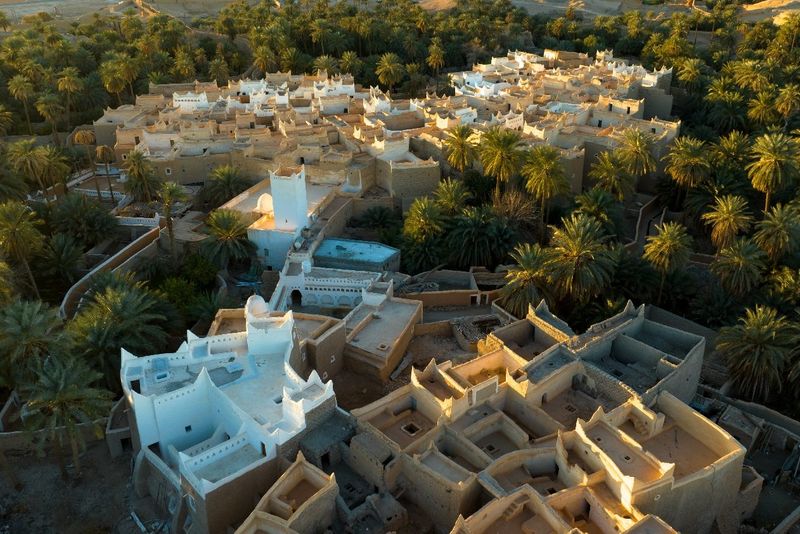
Known as the “pearl of the desert,” Ghadames boasts a mesmerizing old town with interconnected white buildings that create a labyrinth of covered passageways. Women traditionally owned the rooftops, creating a separate world above the streets where they could move freely.
Houses feature intricate geometric decorations inside, with colored glass windows casting rainbow patterns across whitewashed walls. The ancient irrigation system still functions, directing precious water to each property through an ingenious network.
Date palms provide both food and materials for crafts and construction. UNESCO recognized this 7,000-year-old settlement as a World Heritage site for its remarkable architecture that naturally keeps interiors cool despite the scorching desert heat.
4. Tamanrasset, Algeria

Perched high in Algeria’s Hoggar Mountains, Tamanrasset serves as the cultural capital for the blue-robed Tuareg people. The dramatic scenery features volcanic peaks that rise like dark islands from the sandy sea.
Market stalls overflow with silver jewelry, leather goods, and colorful carpets. Mount Assekrem nearby offers one of Africa’s most spectacular sunrise views, with golden light illuminating a landscape that resembles the surface of Mars.
Though modern buildings now dominate parts of the city, traditional mud-brick homes still stand in older neighborhoods. Annual festivals celebrate Tuareg music and dance, drawing visitors from across the Sahara who camp under the stars while listening to the hypnotic sounds of the imzad violin.
5. Djanet, Algeria
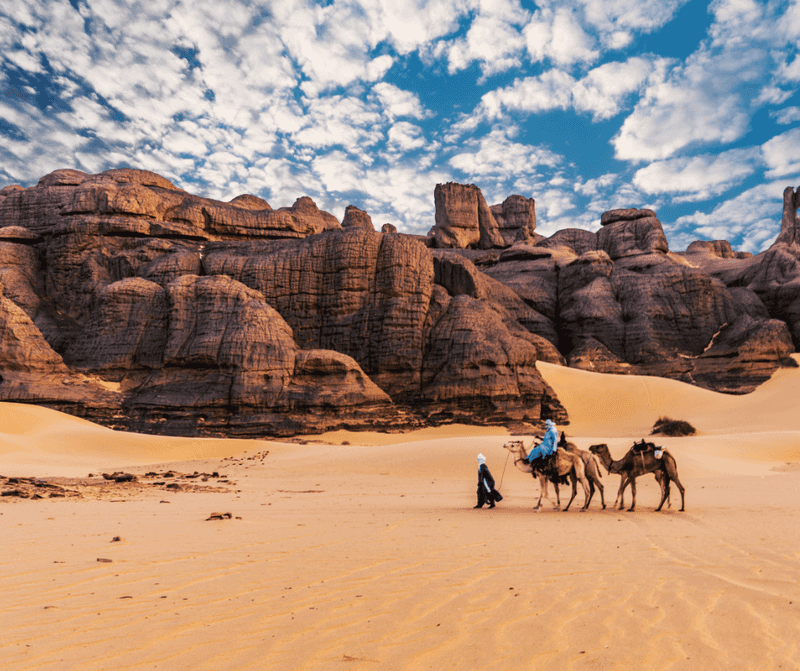
Nestled against towering sandstone cliffs, Djanet serves as the gateway to the otherworldly landscapes of the Tassili n’Ajjer plateau. Palm groves create a green canopy over traditional gardens where locals grow vegetables using ancient irrigation techniques.
The Thursday market buzzes with activity as nomads arrive on camels to trade goods. Just beyond the town, prehistoric rock art dating back 12,000 years depicts a time when the Sahara was lush savanna teeming with elephants, giraffes, and crocodiles.
If you’re lucky, you might witness the Sebiba festival, when Tuareg warriors perform ceremonial dances with swords and shields. At night, the complete absence of light pollution reveals a celestial display that seems close enough to touch.
6. Figuig, Morocco

Seven ancient ksour (fortified villages) cluster around life-giving springs in this frontier oasis near the Algerian border. Figuig’s 200,000 date palms create a microclimate where temperatures drop noticeably as you enter the green canopy.
Ingenious khettara (underground canal systems) distribute water through the gardens according to a complex schedule managed by community elders. The architecture features earthen towers and homes built from compressed soil that keeps interiors naturally cool.
Women weave distinctive carpets with geometric patterns passed down through generations. Despite modern challenges, many families still maintain traditional gardens where they grow dates, figs, pomegranates, and vegetables in the rich soil. The sunset call to prayer echoing across the palms creates an unforgettable sensory experience.
7. Bahariya Oasis, Egypt

Ancient Egyptians called Bahariya the “Northern Oasis,” a fertile depression dotted with hot springs and surrounded by unusual black mountains. Archaeologists discovered the “Valley of the Golden Mummies” here in 1996, unearthing ornate Greco-Roman burial masks that hint at the area’s prosperous past.
Iron deposits give the surrounding landscape a surreal purple and orange hue. Local farmers cultivate dates, olives, apricots, and grapes in gardens irrigated by natural springs.
Desert safaris depart from here to the White Desert, where wind-carved chalk formations resemble giant mushrooms and animals. After dark, visitors often soak in mineral-rich hot springs said to cure rheumatism and other ailments, while gazing at stars that seem close enough to touch.
8. Kufra, Libya
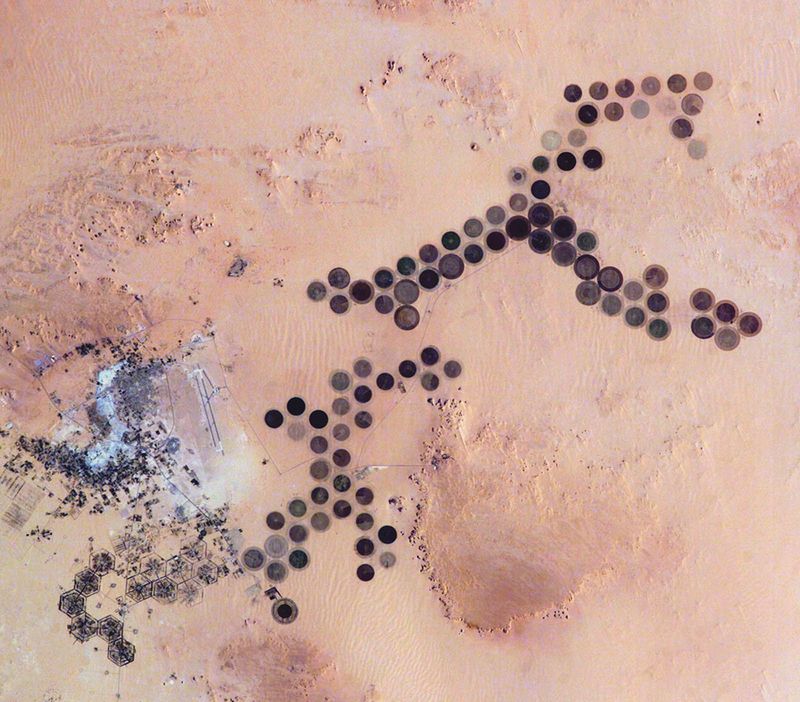
Miles of date palms stretch across this remote oasis in Libya’s southeastern corner, once an important stop on trans-Saharan trade routes. The Great Man-Made River Project now pumps ancient fossil water from massive aquifers beneath Kufra to coastal cities hundreds of miles away.
Circular irrigation systems create perfect green circles visible from space, where crops grow in the midst of one of Earth’s most inhospitable environments. The town itself features a mix of traditional mud-brick architecture and newer concrete buildings.
During World War II, British explorer Ralph Bagnold led daring desert raids from here against Italian forces. Despite its isolation, Kufra maintains connections to the outside world while preserving Saharan traditions like camel racing and date harvesting celebrations that mark the changing seasons.
9. Taghit, Algeria
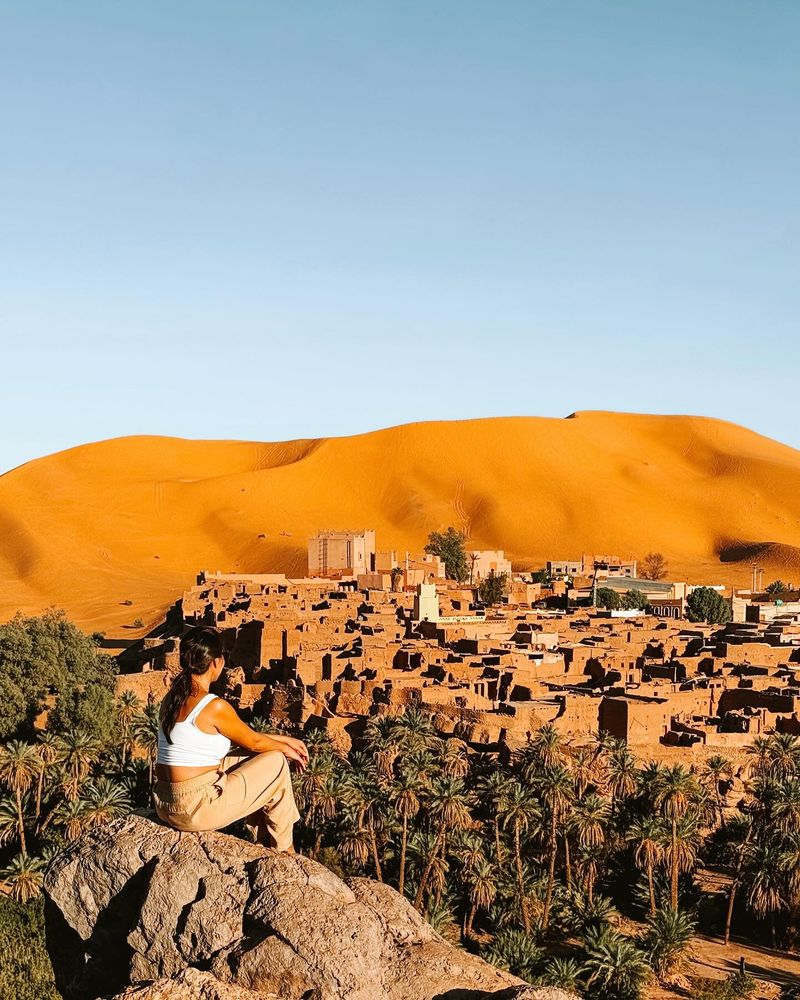
Massive orange sand dunes tower directly over this stunning oasis, creating one of the Sahara’s most dramatic landscapes. Children slide down the slopes on palm fronds while date palms and gardens flourish along the narrow band of fertility.
The old ksar (fortified village) clings to rocky outcrops, its mud-brick buildings connected by narrow passageways designed to provide shade and protection. Nearby rock carvings depict elephants, giraffes and other animals that once roamed this region thousands of years ago.
At sunset, locals and visitors alike climb the dunes to watch the last light paint the landscape gold and crimson. The collision of desert and oasis creates perfect acoustic conditions for traditional music performances that often continue late into the star-filled night.
10. Zagora, Morocco
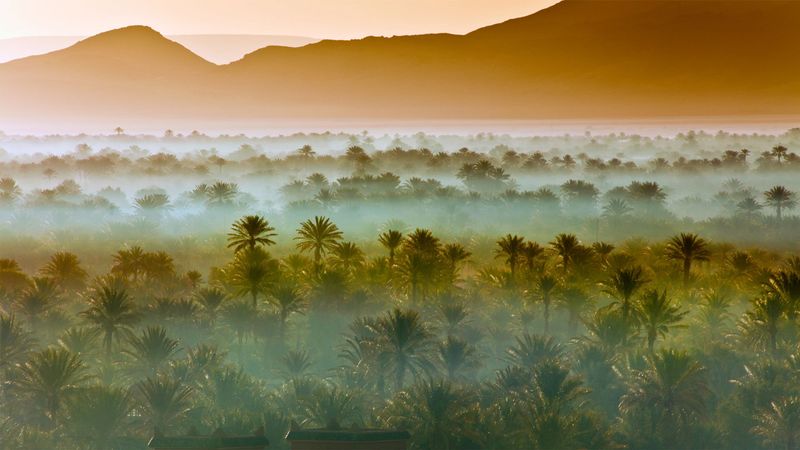
Famous for its sign declaring “Tombouktou 52 days” (by camel), Zagora marks the beginning of the serious desert for travelers heading south from Marrakech. The Draa Valley’s ribbon of palms stretches for miles, creating Morocco’s largest date plantation with over one million trees.
Mountain springs feed an ingenious irrigation system that has sustained life here for centuries. The weekly market draws Berber and Arab traders who arrive with carpets, pottery, and livestock from surrounding regions.
You can still see ruins of the 12th-century Almoravid fortress on the hill overlooking town. Modern Zagora offers a fascinating mix of traditional kasbahs and contemporary amenities, making it an ideal base for desert adventures or experiencing authentic Saharan culture without the extreme isolation of deeper desert oases.
11. El Golea, Algeria
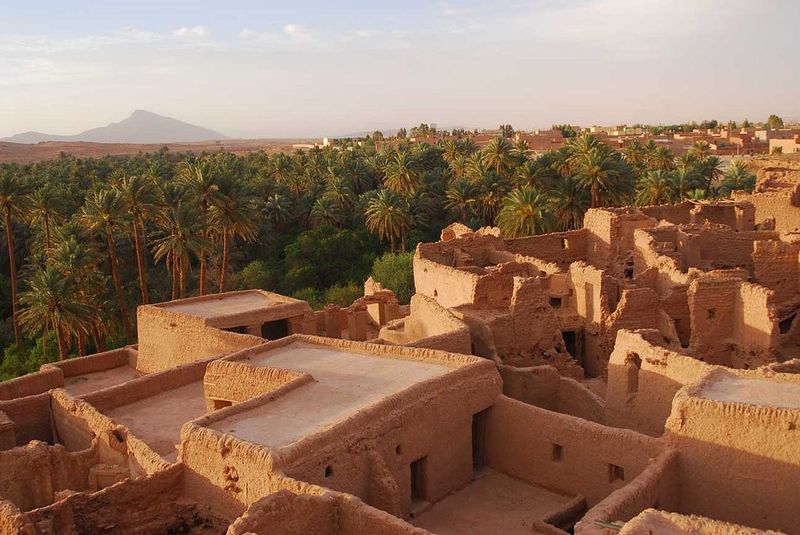
Known as “the pearl of the desert,” El Golea sits at the crossroads of northern and southern Algeria. Two distinct settlements make up this oasis: the new town with its colonial-era buildings and the ancient ksar perched dramatically on a hilltop.
The tomb of Father Charles de Foucauld, a French explorer who became a hermit in the Sahara, attracts pilgrims and tourists alike. Gardens here are famous for their sweet white grapes and dates that thrive in the mineral-rich soil.
Artesian wells feed sparkling blue pools where locals swim to escape the heat. The nearby dunes shift constantly with the wind, sometimes threatening to encroach on cultivated areas. Traditional craftspeople still create intricate silver jewelry and leather goods using techniques passed down through generations.
12. Farafra Oasis, Egypt
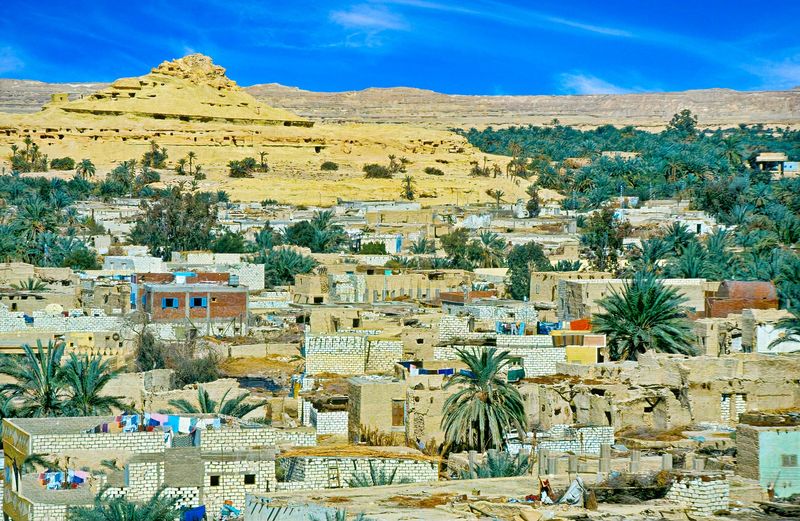
Nicknamed “the land of the cow” due to its historical cattle-raising, Farafra is the smallest and most peaceful of Egypt’s major oases. Hot springs bubble up from the ground, creating steaming pools where locals and visitors soak away desert dust and fatigue.
Distinctive chalk formations in the nearby White Desert appear like giant mushrooms or chickens frozen in time. The local pottery workshop produces unique ceramics from the area’s mineral-rich clay, often decorated with scenes of oasis life.
Bedouin guides lead expeditions into surrounding desert landscapes that seem more like another planet than Earth. Despite increasing tourism, Farafra maintains its agricultural traditions, with families tending fields of wheat, guava trees, and date palms using methods largely unchanged for centuries.
13. Illizi, Algeria
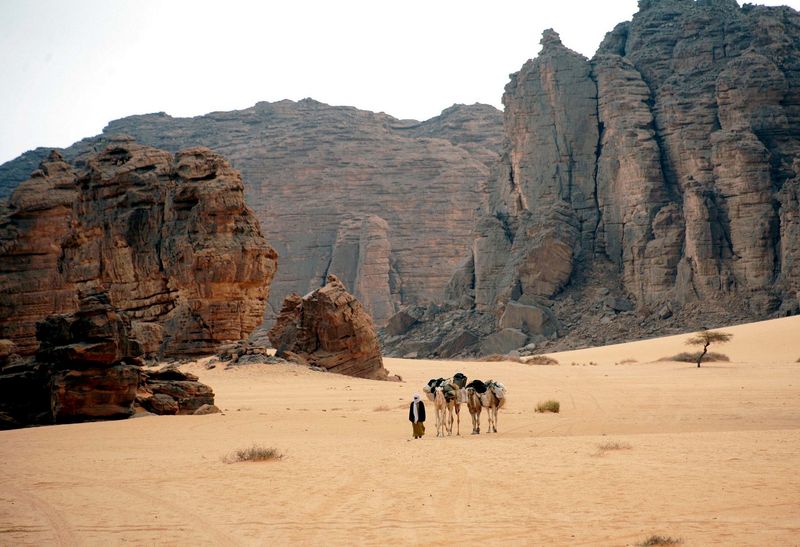
Surrounded by some of the Sahara’s most spectacular rock art, Illizi serves as the gateway to the Tassili n’Ajjer National Park. Ancient engravings and paintings in nearby caves depict a time when hippos and crocodiles inhabited what is now bone-dry desert.
The town itself spreads beneath distinctive flat-topped mountains, with both traditional mud-brick homes and newer concrete buildings. Women craft intricate carpets featuring symbols that tell stories of Tuareg nomadic life.
During the annual Sebiba festival, warriors perform ritualized combat dances that date back centuries. Despite its remote location, solar power now brings electricity to this outpost, while maintaining traditional methods of water conservation remains essential.
The contrast between ancient ways and modern adaptations makes Illizi a fascinating window into Saharan culture.
14. Ounianga Lakes, Chad
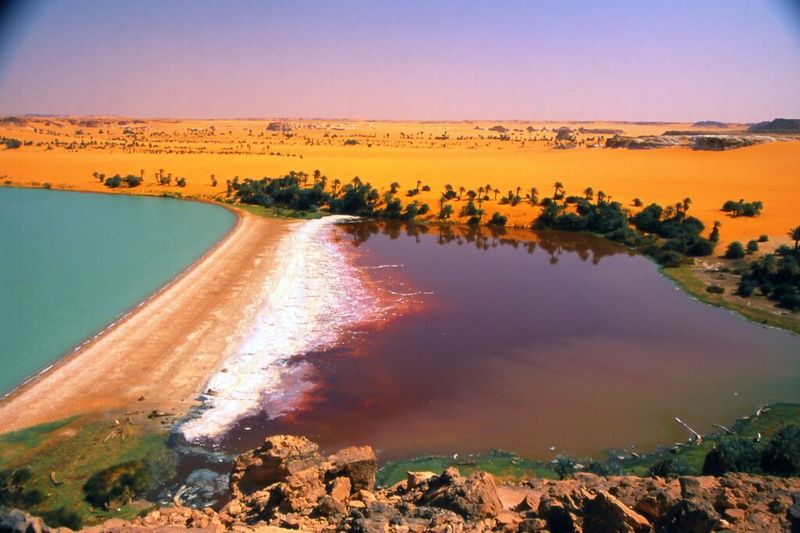
Imagine finding eighteen interconnected lakes shimmering like sapphires in one of the driest parts of the Sahara. The Ounianga lake system exists because ancient groundwater continuously replenishes these bodies of water despite the extreme evaporation.
Some lakes appear deep blue, others green or red depending on their mineral content and algae. Date palms and reeds create patches of intense green against the golden sand. Local fishermen navigate reed boats across waters that have sustained communities here for thousands of years.
UNESCO recognized this hydrological wonder as a World Heritage site in 2012. The largest lake, Yoan, contains water so salty that only specialized microorganisms can survive, while freshwater Lake Teli supports fish and more diverse life. Standing on the shore, the contrast between harsh desert and life-giving water creates an unforgettable sight.
15. Tindouf, Algeria
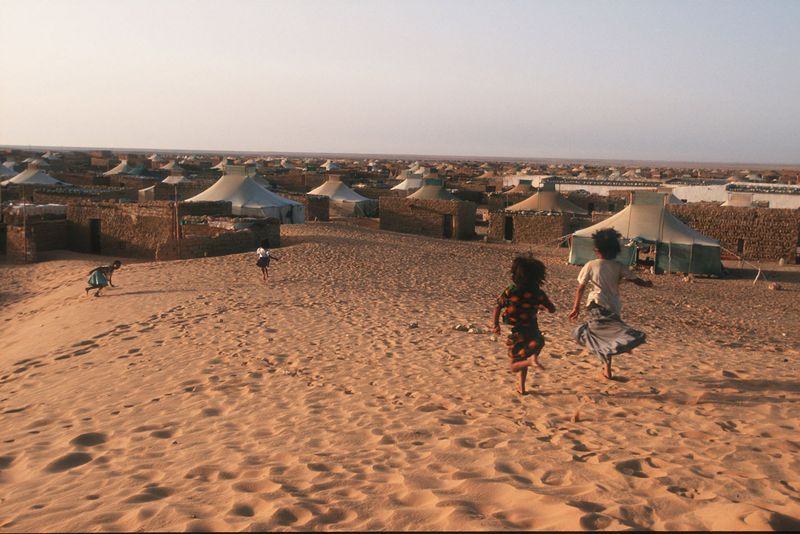
History and politics converge in this frontier oasis near where Algeria, Morocco, and Western Sahara meet. Tindouf serves as headquarters for Sahrawi refugees who fled Western Sahara in the 1970s, creating a unique cultural blend in this remote outpost.
Ancient acacia trees provide sparse shade alongside more recent date palm plantations. The stark landscape features flat-topped mountains that change color throughout the day, from golden morning to deep purple at sunset.
Despite harsh conditions, residents maintain traditions like tea ceremonies where three glasses symbolize life: “The first cup is bitter like life, the second sweet like love, and the third gentle like death.” Modern solar installations now power parts of the settlement, while traditional mud-brick construction still provides the best insulation against extreme temperatures.
16. Tozeur, Tunisia
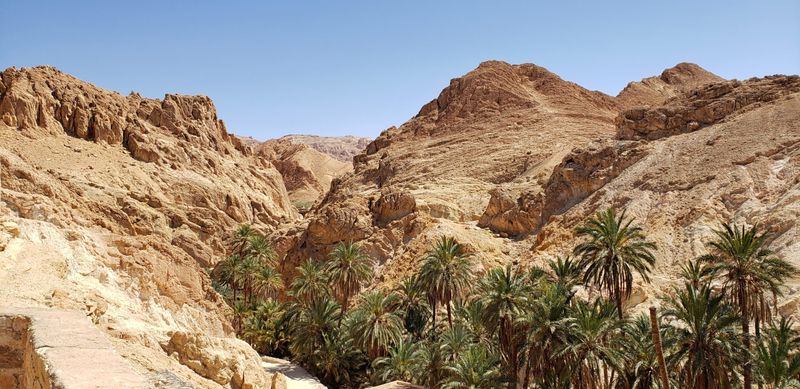
Writers and filmmakers flock to Tozeur for its otherworldly beauty and distinctive architecture featuring protruding bricks laid in mesmerizing geometric patterns. The oasis contains over 200 springs feeding a paradise of 400,000 date palms, particularly the prized Deglet Noor variety.
Horse-drawn carts still transport visitors through the palm grove on narrow paths between irrigation channels. The Eden Palm museum reveals the fascinating 8-month process of date cultivation, from pollination to harvest.
Star Wars fans recognize nearby landscapes from scenes filmed in the area. The medina quarter houses the Dar Cherait Museum with its fascinating dioramas of traditional life. When the afternoon heat subsides, locals gather in cafés to play chess and dominoes while sipping mint tea sweetened with date syrup.
17. Kharga Oasis, Egypt
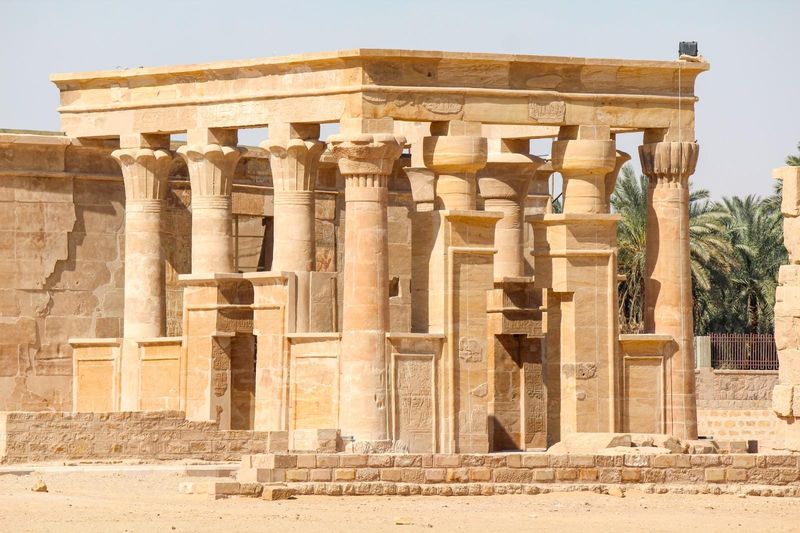
Ancient temples, Christian necropolis, and Islamic monuments reveal the layered history of Egypt’s largest oasis. Kharga served as the last stop on the infamous Forty Days Road that brought slaves and ivory from Sudan during the 19th century.
The Temple of Hibis stands as Egypt’s best-preserved Persian-era temple, its sandstone walls still showing colorful reliefs. Nearby, the Necropolis of Bagawat contains some of the world’s oldest Christian chapels, their mud-brick domes decorated with biblical scenes.
Modern agricultural projects using center-pivot irrigation create perfect green circles in the surrounding desert. Despite development, many families still harvest dates using traditional methods, climbing tall palms with rope harnesses.
18. Rissani, Morocco

Once the crossroads of gold and slave caravans, Rissani stands near the ruins of Sijilmassa, medieval Africa’s greatest Saharan trading city. The market here still buzzes with activity three times weekly when Berber nomads arrive to trade livestock, spices, and handicrafts.
Royal heritage runs deep – this oasis birthed Morocco’s current Alaouite dynasty in the 17th century. The mausoleum of founder Moulay Ali Cherif attracts pilgrims from across the kingdom. Distinctive khettaras (underground irrigation channels) bring precious water to fields of wheat, vegetables, and date palms.
Did you know? The world’s largest fossilized trilobites were discovered nearby, some measuring over two feet long! After exploring the labyrinthine covered market, travelers often head to nearby Erg Chebbi’s towering sand dunes for a taste of the true Sahara.
19. Sebha, Libya
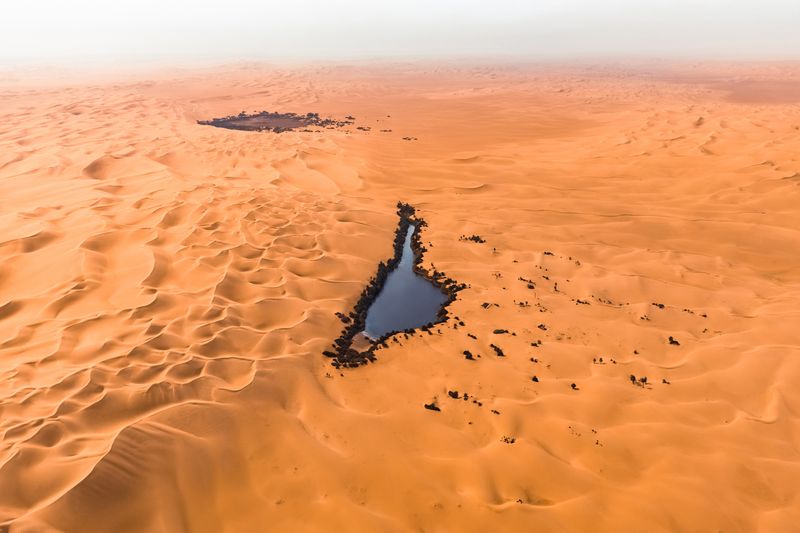
Ancient caravans once brought gold, slaves, and ivory through this crossroads of the central Sahara. Today, Sebha serves as the capital of Libya’s Fezzan region, where modern buildings rise alongside traditional mud-brick structures.
The nearby Ubari Sand Sea contains stunning lakes that appear like mirages among massive dunes. These salt-crusted pools shimmer with an otherworldly blue-green color against the orange sand. The Old Town features narrow winding streets designed to provide shade and protection from desert winds.
Local cuisine reflects Sebha’s position at the crossroads of cultures, with dishes combining Arab, Berber, and sub-Saharan African influences. Despite political challenges in recent years, the oasis continues its centuries-old tradition of hospitality to travelers.
